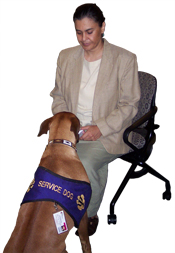Guest Speaker: Psychiatric Service Dogs Are Helping
By Leslie Quander Wooldridge
Editor’s
note: Each
year, SAMHSA staff members are invited
to hear guest speakers present
information on a variety of topics of interest.
 |
| At
a recent in-service at SAMHSA,
Dr. Joan Esnayra introduced one
of her psychiatric service
dogs. She described
how these dogs may help
people with mental illness navigate
their daily lives. Photo
by Kristin Blank |
Anna* has schizophrenia, and Paxil helps her to discern
whether she is hallucinating.
But Paxil doesn’t refer to the widely-known medication
for anxiety—Paxil is the name of her service dog.
Many people are familiar with the images of seeing-eye
dogs that guide their owners across busy streets. Others
may be familiar with service dogs that alert their hearing-impaired
owners to sounds such as doorbells and phones.
But a new grassroots movement is bringing forth another
class of service dogs—a class that may not be
instantly recognizable to members of the public.
Psychiatric
service dogs are supporting owners who
are disabled by mental illness, and these dogs are trained
to do therapeutic work and perform daily tasks.
“When it comes to mental health disabilities,
we’re usually talking about invisible disabilities,” said
Joan Esnayra, Ph.D., founder of the Psychiatric Service
Dog Society in Virginia.
Recently, Dr. Esnayra visited SAMHSA to present at
an in-service event for Agency’s Center for Mental
Health Services. She is a trained geneticist who founded
the society in 2001. As the owner of two psychiatric
service dogs who help her manage bipolar disorder and
post-traumatic stress disorder, she personally has seen
the benefits that service dogs can bring.
Lending Support
Just as traditional service dogs assist owners by performing
physical tasks such as guiding, retrieving, and pulling,
Dr. Esnayra explained that psychiatric service dogs
also help with physical tasks. These dogs can be trained
to interrupt dissociative episodes, provide timely medication
reminders, and create safe personal boundaries for their
owners.
They also perform “work” for their handlers
through therapeutic functions.
Psychiatric service dogs may bark or nudge handlers
who suffer from panic disorders in order to alert them
to oncoming panic attacks, detecting these attacks perhaps
through an olfactory cue. These animals also can help
ease dizziness by bracing or leaning against handlers.
“When physiology changes, dogs notice,” said
Dr. Esnayra, noting that when dogs exhibit uncharacteristic
behavior, such as pacing, staring, or vocalizing, the
dogs may be ”alerting” to an incipient episode.
“With
reliable canine alerting, you have choices in how to
manage or subvert the episode using cognitive skills,
risk reduction behaviors, or PRN [given as needed] medication,” she
explained. “Canine alerting behaviors facilitate
the development of insight in the client, and this makes
all the difference between functioning and not functioning.”
In addition to providing valuable alerts to handlers,
these dogs also provide support for everyday activities.
For example, service dogs have helped people with agoraphobia
venture out in public again.
“This is a 24/7 human-canine partnership,” Dr.
Esnayra explained, as her two ginger-colored Rhodesian
Ridgebacks looked on. “Even if someone doesn’t
fully comprehend the mechanisms of this intervention,
they can still benefit from it.”
Back
to Top
Training Tasks
In general, there are three aspects of service dog
training: basic obedience, public access skills, and
disability-related tasks or therapeutic functions (work).
Owners of service dogs are not required to obtain professional
training services, but Dr. Esnayra noted that the assistance
of a professional can be valuable. “The law allows
you to train your own service dog,” she said,
also recommending that handlers join the listserv of
the Psychiatric Service Dog Society to obtain expert
guidance that can be passed on to a professional dog
trainer.
Dr. Esnayra said there are about 5,000 psychiatric
service dogs throughout the Nation, and handlers should
expect to train their dogs for about a year before dogs
can begin working.
Dogs of many breeds can be service
animals, but Dr. Esnayra warned against
high-energy breeds such as Dalmatians and Jack Russell
Terriers.
Although many people may want to rescue dogs from shelters
and prepare them for service dog training, Dr. Esnayra
says purebred puppies from show breeders offer the least
risk medically, as the ancestry of these dogs is known
and training can begin early.
She added that training
is an ongoing and essential process,
so handlers should be prepared to invest the requisite
time and money.
She also pointed out that psychiatric service dogs
are not pets under the law and are permitted in restaurants,
for example. However, even though service dogs legally
can accompany handlers into public areas, handlers may
face some resistance, especially because they are invisibly
disabled.
So, the society founder said handlers should
learn about service dog access laws,
including the Americans with Disabilities Act, the Fair
Housing Act, and their own state laws.
“This is a do-it-yourself situation, and it takes
a long time,” Dr. Esnayra explained. But as her
two dogs watched her with rapt attention, she continued, “I
happen to think the human/canine partnership is a sacred
honor.”
For more information on the Psychiatric Service Dog
Society, or to read the related literature, visit www.psychdog.org.
For more information on mental health, visit www.samhsa.gov. 
* A pseudonym
« Previous
Article
Next
Article »
Back
to Top
|


